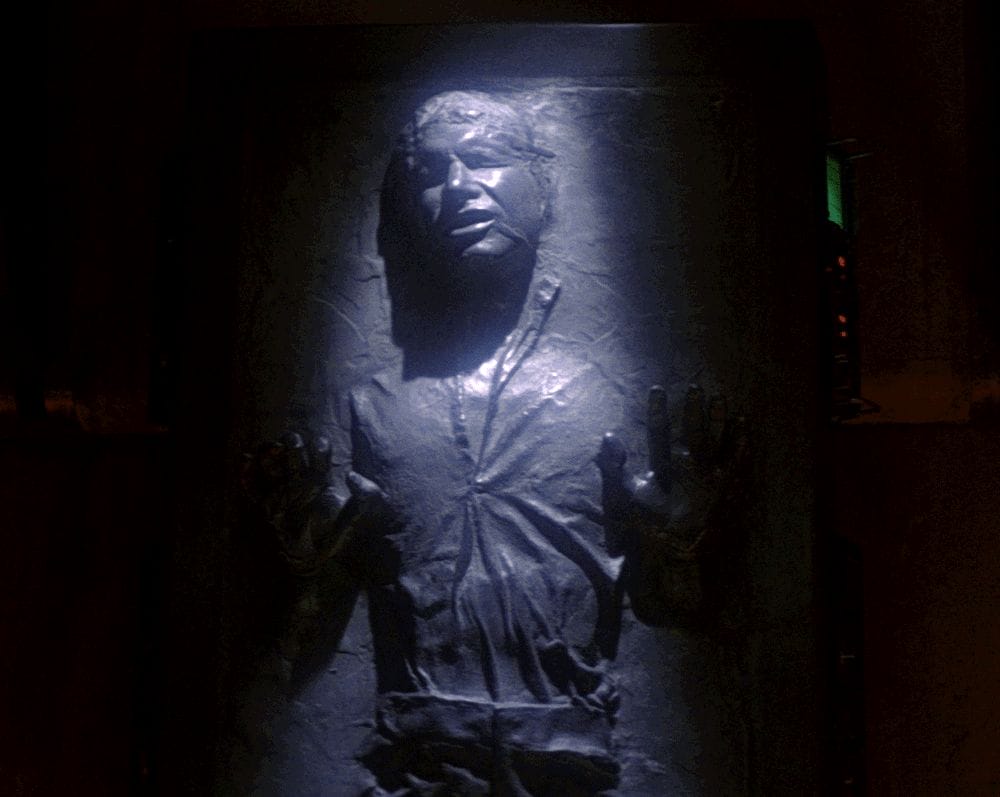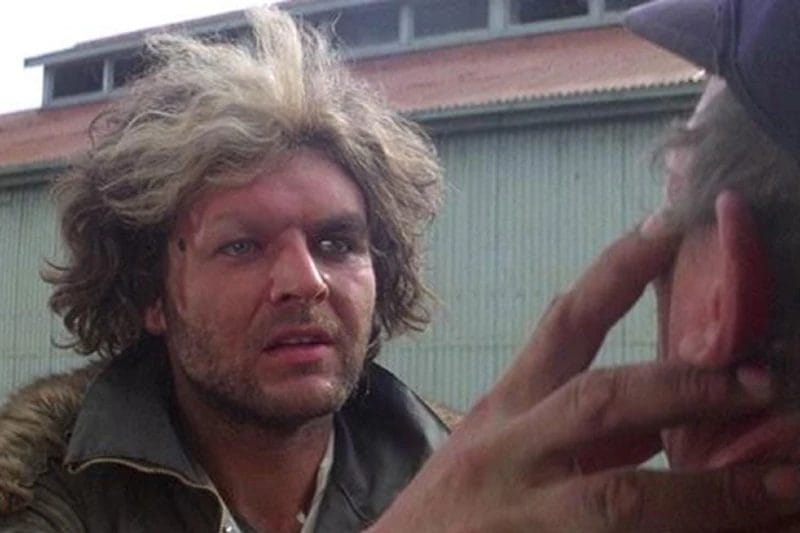Science fiction writers invented some of the best technology we as a society could desire. One caveat, though, I’m still waiting for my flying car; just saying. But not every technological invention gives you a warm and fuzzy feeling, am I right? Some are down-right creepy. Others may not come across as that scary until you lift the veil and understand how the technology works. We, as humans, are far past our days of living in caves and fearing saber-tooth tigers. Yet, we still fear the unknown. The sci-fi genre lives – thrives – in this strange realm. It’s in the dark, damp caves of our mind, toying with our deepest fears by inventing the scariest technology.
The list below reflects the most frightening sci-fi technology that gives me the creeps.
5. Teleporters
Teleporters seem so exciting and straightforward. Oh, the possibilities! Imagine the end of traffic congestion; airlines and trains would disappear overnight. Consider the positive environmental impact such technology would enable!
We must consider how teleporters, this fantastic creation of science fiction, would work. As a child watching Star Trek: The Next Generation in the 1980s, I imagined the officers of Star Fleet transmitted like light to their intended destination (which was accurate). I had no reason to fear this technology. Nay, it even excited me to the possibility of it becoming a reality.
Whether it’s “Beam me up, Scotty”, or “Energize,” an away team steps up onto the teleporter, disappears, then reappears at their intended destination. The scariest part of Trek teleporting is materializing into a physical object, not appearing on land, or setting somewhere far away from the intended destination. All three scenarios give me the chills, although less so with the latter.
Then I watched The Outer Limites episode “Think Like a Dinosaur,” from season 7, episode 8. Whoa. New thoughts now littered my brain, with ethics at the forefront. In this episode, The Outer Limits took the time to explain how teleportation works (or at least their concept of it) in detail by slowing down the pace of the teleportation experience.
Let’s consider how the teleporters work, as explained by The Outer Limits. A source teleporter scans your body at an atomic level. It then copies your “source code,” and reproduces an exact match at the destination teleporter. Now there are two of the same actual person. To “balance the equation,” an administrator at the source teleporter must kill the original person.
“As we pursue technological advancement, we should be careful not to abandon our humanity in the process.”
-Narrator at the end of The Outer Limits episode “Think Like a Dinosaur.”
What about the “Telepods” from the movie The Fly (1986)? As Seth Brundle (great first name), Jeff Goldblum stars as a brilliant scientist researching matter transportation. During an attempt to transport himself, a fly lands in the source “Telepod,” unbeknownst to the scientist. When Brundle materializes in the destination “Telepod,” his genes are now combined with the fly. Over time, Brundle transforms into a human-fly creature. It’s no wonder The Fly is the source of the iconic quote, “Be afraid. Be very afraid.”
4. Cryogenic Chambers
Cryonics. What an exciting word. It’s a term popularized by Robert Chester Wilson Ettinger in his 1962 book The Prospect of Immortality. As a child, Ettinger grew up reading Hugo Gernsback’s Amazing Stories, and one story, in particular, Neil R. Jones’s “The Jameson Satellite,” inspired his idea of cryonics.
Since then, cryonics appeared in science fiction works in all types of media: film, novels, short stories, comics, and video games. Cryogenic chambers make long-distance space travel possible without traveling at or beyond the speed of light. With the prospect of cryonics allowing for immortality, what could make it creepy?
Allow me to cite a few examples for you.
The most famous example of a frozen animation is none other than Han Solo getting imprisoned in carbonite by Darth Vader. In Star Wars: Episode V – The Empire Strikes Back (1980), Darth Vader intended to capture his son, Luke, and imprison him in carbonite. In the Star Wars franchise universe, carbonite is a liquid substance made from carbon gas that could change into a solid through rapid freezing. Most often used to encase goods to preserve them for long space voyages, carbonite placed people into hibernation.

To understand how terrifying using carbonite to imprison a person is, look at Han Solo’s face after he’s frozen in place. This process has harsh side effects, too, called hibernation sickness. When released from his carbonite prison, Solo couldn’t see for quite a while.
But wait, there’s more!
In Alien3 (1992), Sigourney Weaver’s heroic character, Ellen Ripley, is impregnated by a Queen Facehugger while she’s asleep in cryonic stasis. Please tell me that doesn’t scare the heck out of you, and I’ll call you a liar!
Let’s stick with the Alien franchise for a second. In Alien: Covenant (2017), ship captain Jake Branson (an uncredited role by James Franco) burns alive when his cryonic stasis pod malfunctions.

A lesser-known sci-fi thriller, Wes Craven’s Chiller (1985) explores the effect of cryonic preservation on the mind. Michael Bek plays Miles Creighton, who dies and is then cryonically-preserved for later revival. Finally, ten years later, cryonic technology improves, and Miles gets revived. That’s when bodies start dropping like flies, and all evidence points to Miles.
Demolition Man (1993) follows a similar story in which cryogenically-frozen prisoners carry out sentences. Wesley Snipes’ antagonist character Simon Phoenix thaws for a parole hearing stemming from crimes he committed in 1996. He escapes. In the future Phoenix awakes to, crime is now non-existent, and society is unable to handle a criminal like Phoenix. For you Aldous Huxley fans like me, Demolition Man pays homage to the famous author’s best work, Brave New World. Sandra Bullock’s character Lieutenant Lenina Huxley’s name comes from Lenina, a primary character of Brave New World, and the author’s last name.
Most frightening about Demolition Man is the prison system’s subliminal behavioral conditioning and skills training the frozen prisoners receive without their awareness.
As with NCI, cryonics frightens me because of the lack of control one experiences while frozen. I associate it with being held down against your will blended with a little claustrophobia.
3. Neural Control Interfaces
Neural control interfaces (NCI), often referred to as brain-computer interfaces, are an emerging technology. Current uses of this technology allow amputees to control artificial limbs. Despite the benefits, science fiction has a sordid history portraying the worst capabilities technology can achieve.
In the movie The Matrix (1999), a war between humans and intelligent machines culminated when humans detonated nuclear missiles intended to block out the sun. Humans assumed the machines would be unable to recharge with the sun blocked, presumably guaranteeing humanity’s victory. But, humans didn’t expect the machines’ sickening alternative to solar energy: using human beings as batteries. The machines created the Matrix, a false reality that kept the human minds active, and their physical bodies living. Humans had “headjacks” installed at the base of their skull, providing a physical interface into the Matrix. Consider how frightful that technology is. Humans, trapped in pods, living a false life while in reality they’re enslaved to the machines they created.
In eXistenZ (1999), a biotechnological virtual reality game console has replaced electronic ones. These “game pods” have “UmbryCords” that attach to “bio-ports,” like the “headjacks” in Matrix. In both Matrix and eXistenZ, if you die in virtual reality while connected using an NCI, you die in the real world, too.
Matrix isn’t the only movie that depicts how frightful neural control interfaces are, either. In the movie Inception (2010), Leonardo DiCaprio plays a professional thief specializing in corporate espionage. He infiltrates the subconscious of his targets to discover their deepest regarded secrets. In Johnny Mnemonic, one of Keanu Reeves’s biggest blockbuster flops, the titular character uses a cybernetic brain implant to store information. This capability requires Johnny to lose memories of his childhood. What a tragic trade-off.
In Spider-Man 2 (2004), Dr. Otto Octavius, an innocent scientist testing his newest invention, uses a neural control interface to control mechanical tentacles attached to his back. The experiment goes awry, and the NCI leaves him neurologically fused to the tentacles, transforming him into the evil Doctor Octopus.
In Philip K. Dick’s book Do Androids Dream of Electric Sheep, which inspired the movie Blade Runner (1982), people use Penfield Mood Organs to regulate their moods. Some people, like protagonist Rick Deckard’s wife, often use the mood organ in frightful ways.
“But a mood like that,” Rick said, “you’re apt to stay in it, not dial your way out…” I program an automatic resetting for three hours later,” his wife said sleekly. “A 481. Awareness of the manifold possibilities open to me in the future: new hope that—” I know 481,” he interrupted. He had dialed out the combination many times; he relied on it greatly.
-Rick Deckard, speaking to his wife about using a Penfield Mood Organ
The list goes on.
In Eternal Sunshine of the Spotless Mind (2004), memory manipulation via an NCI wipes memories in participants’ minds. The same thing happens in Paycheck (2003), starring Ben Affleck as protagonist Michael Jennings. Jennings earns lucrative contracts with large corporations to reverse engineer competitors’ latest technology. After each project, Jennings undergoes a memory wipe via an NCI. Terrifying.
Men in Black (1997) use a Neuralyzer to wipe the memories of anyone they deem necessary to keep aliens a secret from society. Strange Days (1995), set in the last two days of 1999, depicts the use of “SQUIDS,” an illegal electronic device that records memories and physical sensations by connecting to the user’s cerebral cortex. “SQUIDS” reminds me of the OASIS Neural Interface (ONI) from Ernest Cline’s newest book, Ready Player Two (2020). In RP2, if you die in OASIS, your physical body lays comatose until you log off.
Elysium (2013) uses NCI to control surgically-installed exoskeletons. In Avatar (2009), NCI allows humans to control genetically engineered Na’vi bodies, and in Surrogates (2009), humans use NCI to control androids called “surrogates”.
Yes, much good can, and likely will, come from NCI. But, any device capable of manipulating our brains, which we don’t know whether we are in reality or virtual reality, creeps me out. As with most people, I fear losing control of my mind.
2. Genetic Engineering
Genetic Engineering encompasses the most comprehensive array of science fiction movies. I consider Jurassic Park (1993), my favorite film, as the best example of genetic engineering in a sci-fi movie. The entire franchise of Jurassic movies showcases two points. First, the ability to manipulate DNA will always find a surreptitious use by corporations. Second, genetically engineered creations will have flaws and pose a severe risk to humanity.
Genetic engineering became a reality in 1973 when Herbert Boyer and Stanley Cohen created the first successful genetically engineered organism. By the 1980s, corporations like General Electric leveraged this newfound technology to create a new kind of bacteria, for example, designed to break down crude oil in spill cleanups.
Today, we live in a world where genetically modified organisms (GMO) dominates the agriculture industry. Almost all food available today stems from a GMO. When you factor in concepts such as overpopulation, pollution, and world hunger, the idea of genetic engineering sounds promising.
However, as per usual, our beloved sci-fi creators happily point out the terrifying capabilities of genetic engineering.
Consider one of the greatest science fiction movies ever made, Blade Runner. The Tyrell Corporation created “replicants,” a bioengineered human having superior strength, speed, agility, resilience, and intelligence. Before the events of the film, replicants initiated an off-world mutiny to escape their imposed slavery from their human creators. You see, their human creators feared these replicants. Blade Runners, the equivalent of police officers, used the Voight-Kampff test to detect emotional responses during a set of questions while interviewing possible replicants. The Tyrell Corporation included a safety mechanism in the Nexus-6 model replicants. After a four-year lifespan, the replicants “expired.” The reason for this? To prevent the Nexus-6 replicants from developing empathic abilities, thus giving them immunity to the Voight-Kampff test.
Fear of the unknown drives humanity to make drastic, although often disastrously incorrect, decisions, just like in reality. There are plenty of other examples of genetic engineering gone awry.
- Alien movie franchise (after Alien: Covenant retcon)
- Planet of the Apes movie franchise
- Resident Evil movie franchise
- Star Wars: Episode II – Attack of the Clones (2002)
- Rampage (2018)
- Gattaca (1997)
- Okja (2017)
- Splice (2009)
- Mimic (1997)
I could almost go on forever, but you get the point. Taken to the extreme, genetic engineering is down-right creepy.
If you want to read a great book that contains a bit of genetic engineering, check out this post!
1. Artificial Intelligence
Ah, artificial intelligence. You had to know this technology would make my list, right? No technology gets blamed for the extinction of humanity than sentient artificial intelligence. Humanity fears anything smarter or stronger than it. We want to avoid extinction, like the Neanderthals.
The best movie to depict humanity’s fear of artificial intelligence is the film with the same name: A.I. Artificial Intelligence (2001). Steven Spielberg’s film explores human nature in depth. The film covers mother-son relationships, mob mentality, racism (or speciesism?), what it means to be human, grief, love, and so much more. It’s a gut-wrenching movie at times. By placing yourself firmly in David’s (the android) shoes, you experience the terror the A.I. faces, mainly while he’s hunted.
A.I. Artificial Intelligence has a terrifying perspective, but that’s not what most people associate with scary A.I. Most people think of world-destroying sentient beings like Skynet from The Terminator (1984), HAL 9000 from 2001: A Space Odyssey (1968), the computer in Logan’s Run (1976), Autopilot (AUTO) from Wall-E (2008), Ash/Mother/David from the Alien franchise, Agent Smith in The Matrix and so many more.
The best humanity can hope for is a symbiotic relationship with sentient A.I. once it becomes a reality (which it inevitably will). However, history typically makes the best teacher. If the past indicates how the future plays out with superior sentient beings, I doubt things will work out well for us humans.
What’s more creepy to think about than the extinction of the entire human race?
If you want to read more about Logan’s Run, check out this post!



